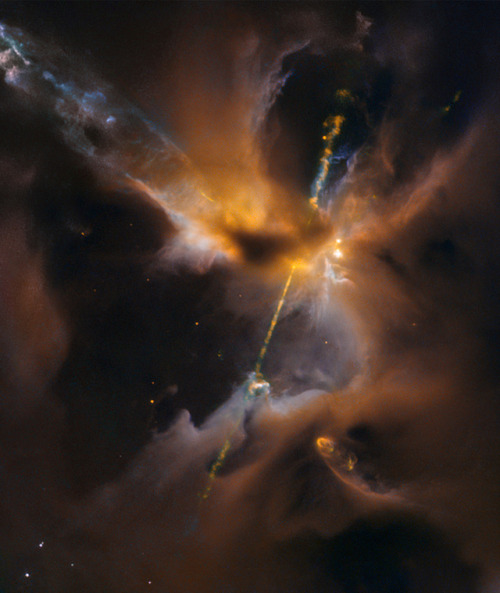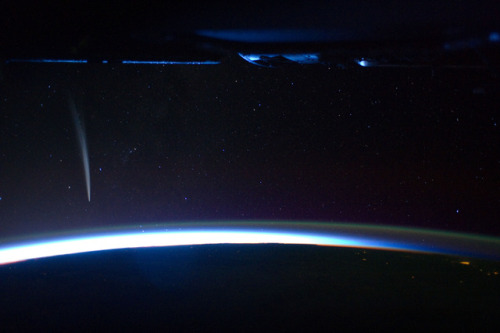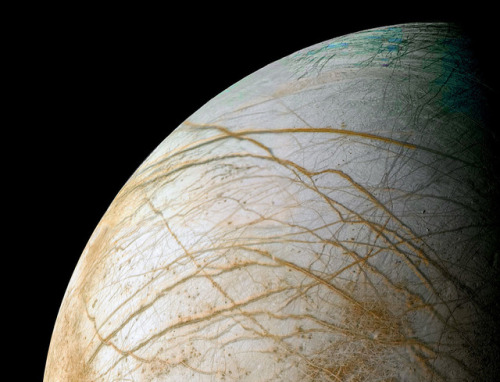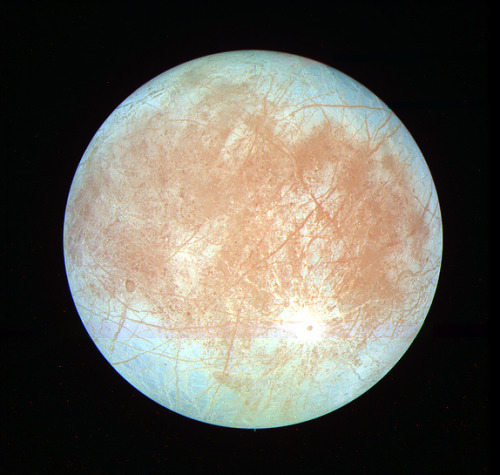The Missing Links Between Galaxies Have Finally Been Found. This Is The First Detection Of The Roughly

The missing links between galaxies have finally been found. This is the first detection of the roughly half of the normal matter in our universe – protons, neutrons and electrons – unaccounted for by previous observations of stars, galaxies and other bright objects in space.
More Posts from Xyhor-astronomy and Others
![Andromeda [x]](https://64.media.tumblr.com/aa70ce40e59ba0f9da6e334afac731fe/tumblr_ox11noOQXn1tuy5mao1_500.jpg)
Andromeda [x]
js

Hubble Sees the Force Awakening in a Newborn Star
This celestial lightsaber does not lie in a galaxy far, far away, but rather inside our home galaxy, the Milky Way. It’s inside a turbulent birthing ground for new stars known as the Orion B molecular cloud complex, located 1,350 light-years away.
In the center of the image, partially obscured by a dark, Jedi-like cloak of dust, a newborn star shoots twin jets out into space as a sort of birth announcement to the universe
Credit: NASA/ESA

Comet Lovejoy is visible near Earth’s horizon in this nighttime image photographed by NASA astronaut Dan Burbank, Expedition 30 commander, onboard the International Space Station on Dec. 21, 2011.
Image credit: NASA
A Hitchhiker’s Ride to Space
This month, we are set to launch the latest weather satellite from the National Oceanic and Atmospheric Administration (NOAA). The Joint Polar Satellite System-1, or JPSS-1, satellite will provide essential data for timely and accurate weather forecasts and for tracking environmental events such as forest fires and droughts.

Image Credit: Ball Aerospace
JPSS-1 is the primary satellite launching, but four tiny satellites will also be hitchhiking a ride into Earth orbit. These shoebox-sized satellites (part of our CubeSat Launch Initiative) were developed in partnership with university students and used for education, research and development. Here are 4 reasons why MiRaTA, one of the hitchhikers, is particularly interesting…

Miniaturized Weather Satellite Technology
The Microwave Radiometer Technology Acceleration (MiRaTA) CubeSat is set to orbit the Earth to prove that a small satellite can advance the technology necessary to reduce the cost and size of future weather satellites. At less than 10 pounds, these nanosatellites are faster and more cost-effective to build and launch since they have been constructed by Principal Investigator Kerri Cahoy’s students at MIT Lincoln Laboratory (with lots of help). There’s even a chance it could be put into operation with forecasters.

The Antenna? It’s a Measuring Tape
That long skinny piece coming out of the bottom right side under MiRaTA’s solar panel? That’s a measuring tape. It’s doubling as a communications antenna. MiRaTA will measure temperature, water vapor and cloud ice in Earth’s atmosphere. These measurements are used to track major storms, including hurricanes, as well as everyday weather. If this test flight is successful, the new, smaller technology will likely be incorporated into future weather satellites – part of our national infrastructure.

Tiny Package Packing a Punch MiRaTA will also test a new technique using radio signals received from GPS satellites in a higher orbit. They will be used to measure the temperature of the same volume of atmosphere that the radiometer is viewing. The GPS satellite measurement can then be used for calibrating the radiometer. “In physics class, you learn that a pencil submerged in water looks like it’s broken in half because light bends differently in the water than in the air,” Principal Investigator Kerri Cahoy said. “Radio waves are like light in that they refract when they go through changing densities of air, and we can use the magnitude of the refraction to calculate the temperature of the surrounding atmosphere with near-perfect accuracy and use this to calibrate a radiometer.”

What’s Next?
In the best-case scenario, three weeks after launch MiRaTA will be fully operational, and within three months the team will have obtained enough data to study if this technology concept is working. The big goal for the mission—declaring the technology demonstration a success—would be confirmed a bit farther down the road, at least half a year away, following the data analysis. If MiRaTA’s technology validation is successful, Cahoy said she envisions an eventual constellation of these CubeSats orbiting the entire Earth, taking snapshots of the atmosphere and weather every 15 minutes—frequent enough to track storms, from blizzards to hurricanes, in real time.
Learn more about MiRaTA
Watch the launch!

The mission is scheduled to launch this month (no sooner than Nov. 14), with JPSS-1 atop a United Launch Alliance (ULA) Delta II rocket lifting off from Space Launch Complex 2 at Vandenberg Air Force Base in California. You’ll be able to watch on NASA TV or at nasa.gov/live.

Watch the launch live HERE on Nov. 14, liftoff is scheduled for Tuesday, 4:47 a.m.!
Make sure to follow us on Tumblr for your regular dose of space: http://nasa.tumblr.com.

Meteor impact craters of the world










The Largest Black Hole Merger Of All-Time Is Coming, And Soon
“Over in Andromeda, the nearest large galaxy to the Milky Way, a number of unusual systems have been found. One of them, J0045+41, was originally thought to be two stars orbiting one another with a period of just 80 days. When additional observations were taken in the X-ray, they revealed a surprise: J0045+41 weren’t stars at all.”
When you look at any narrow region of the sky, you don’t simply see what’s in front of you. Rather, you see everything along your line-of-sight, as far as your observing power can take you. In the case of the Panchromatic Hubble Andromeda Treasury, where hundreds of millions of stars were captured in impressive fashion, background objects thousands of times as distant can also be seen. One of them, J0045+41, was originally thought to be a binary star system that was quite tight: with just an 80 day orbital period. Follow-up observations in the X-ray, however, revealed that it wasn’t a binary star system after all, but an ultra-distant supermassive black hole pair, destined to merge in as little as 350 years. If we build the right observatory in space, we’ll be able to observe the entire inspiral-and-merger process for as long as we like!
Come get the full story, and some incredible pictures and visuals, on today’s Mostly Mute Monday!









Europa
Jupiter’s moon Europa is slightly smaller than Earth’s moon. Its surface is smooth and bright, consisting of water ice crisscrossed by long, linear fractures. Like our planet, Europa is thought to have an iron core, a rocky mantle and an ocean of salty water beneath its ice crust. Unlike Earth, however, this ocean would be deep enough to extend from the moon’s surface to the top of its rocky mantle. Being far from the sun, the ocean’s surface would be globally frozen over. While evidence for this internal ocean is quite strong, its presence awaits confirmation by a future mission.
Europa orbits Jupiter every 3.5 days and is locked by gravity to Jupiter such that the same hemisphere of the moon always faces the planet. Because Europa’s orbit is slightly stretched out from circular, or elliptical, its distance from Jupiter varies, creating tides that stretch and relax its surface. The tides occur because Jupiter’s gravity is just slightly stronger on the near side of the moon than on the far side, and the magnitude of this difference changes as Europa orbits. Flexing from the tides supplies energy to the moon’s icy shell, creating the linear fractures across its surface. If Europa’s ocean exists, the tides might also create volcanic or hydrothermal activity on the seafloor, supplying nutrients that could make the ocean suitable for living things.

Europa Clipper
NASA’s planned Europa Clipper would conduct detailed reconnaissance of Jupiter’s moon Europa and investigate whether the icy moon could harbor conditions suitable for life.
The mission would place a spacecraft in orbit around Jupiter in order to perform a detailed investigation of the giant planet’s moon Europa – a world that shows strong evidence for an ocean of liquid water beneath its icy crust and which could host conditions favorable for life. The mission would send a highly capable, radiation-tolerant spacecraft into a long, looping orbit around Jupiter to perform repeated close flybys of Europa. NASA has selected nine science instruments for a future mission to Europa. The selected payload includes cameras and spectrometers to produce high-resolution images of Europa’s surface and determine its composition. An ice penetrating radar would determine the thickness of the moon’s icy shell and search for subsurface lakes similar to those beneath Antarctica’s ice sheet. The mission would also carry a magnetometer to measure the strength and direction of the moon’s magnetic field, which would allow scientists to determine the depth and salinity of its ocean.
Image credit: NASA / JPL / Galileo / Voyager & Processed by Kevin M. Gill
Credit: NASA & Europa Clipper Mission
Flying Monsters of Scorpius | Yuriy Toropin
Take in the Surreal Beauty of Jupiter in These Incredible New Images NASA released the raw data earlier this week, allowing the public to process the beautiful images

Planet Neptune, observed by the Voyager 2 space probe, August 25, 1989.
(NASA)
-
 mayta1000 liked this · 4 years ago
mayta1000 liked this · 4 years ago -
 rwa001-blog liked this · 5 years ago
rwa001-blog liked this · 5 years ago -
 who-we-were liked this · 6 years ago
who-we-were liked this · 6 years ago -
 randomroundabout-blog liked this · 6 years ago
randomroundabout-blog liked this · 6 years ago -
 korg0222 liked this · 7 years ago
korg0222 liked this · 7 years ago -
 scotty1260 liked this · 7 years ago
scotty1260 liked this · 7 years ago -
 reussff reblogged this · 7 years ago
reussff reblogged this · 7 years ago -
 laye113 liked this · 7 years ago
laye113 liked this · 7 years ago -
 anthown35 liked this · 7 years ago
anthown35 liked this · 7 years ago -
 beast1190 liked this · 7 years ago
beast1190 liked this · 7 years ago -
 skyguysblog liked this · 7 years ago
skyguysblog liked this · 7 years ago -
 pog-sev-blog liked this · 7 years ago
pog-sev-blog liked this · 7 years ago -
 germainium-blog1 liked this · 7 years ago
germainium-blog1 liked this · 7 years ago -
 theballadoffinchesandsaints liked this · 7 years ago
theballadoffinchesandsaints liked this · 7 years ago -
 noisyramen-blog liked this · 7 years ago
noisyramen-blog liked this · 7 years ago -
 christophernealsimmons liked this · 7 years ago
christophernealsimmons liked this · 7 years ago -
 deltacuberecords-blog liked this · 7 years ago
deltacuberecords-blog liked this · 7 years ago -
 alientraveller999-blog reblogged this · 7 years ago
alientraveller999-blog reblogged this · 7 years ago -
 alientraveller999-blog liked this · 7 years ago
alientraveller999-blog liked this · 7 years ago -
 joeljohn18-blog reblogged this · 7 years ago
joeljohn18-blog reblogged this · 7 years ago -
 leetjack liked this · 7 years ago
leetjack liked this · 7 years ago -
 coolbreadcollectionposts-blog liked this · 7 years ago
coolbreadcollectionposts-blog liked this · 7 years ago -
 chocolateobjectpeach-blog reblogged this · 7 years ago
chocolateobjectpeach-blog reblogged this · 7 years ago -
 chocolateobjectpeach-blog liked this · 7 years ago
chocolateobjectpeach-blog liked this · 7 years ago -
 compare-bear liked this · 7 years ago
compare-bear liked this · 7 years ago -
 alvazi3 liked this · 7 years ago
alvazi3 liked this · 7 years ago -
 manadh-olthaven-blog reblogged this · 7 years ago
manadh-olthaven-blog reblogged this · 7 years ago -
 yunochiken-blog reblogged this · 7 years ago
yunochiken-blog reblogged this · 7 years ago -
 kukuruzzzka-sir-blog liked this · 7 years ago
kukuruzzzka-sir-blog liked this · 7 years ago -
 mylauraperez-blog1 liked this · 7 years ago
mylauraperez-blog1 liked this · 7 years ago -
 thejunebugposts-blog liked this · 7 years ago
thejunebugposts-blog liked this · 7 years ago -
 ciapatay-blog liked this · 7 years ago
ciapatay-blog liked this · 7 years ago -
 qualitytimemachineladyavdsd-blog liked this · 7 years ago
qualitytimemachineladyavdsd-blog liked this · 7 years ago -
 tormentedcreep liked this · 7 years ago
tormentedcreep liked this · 7 years ago -
 jeffblaize liked this · 7 years ago
jeffblaize liked this · 7 years ago
For more content, Click Here and experience this XYHor in its entirety!Space...the Final Frontier. Let's boldly go where few have gone before with XYHor: Space: Astronomy & Spacefaring: the collection of the latest finds and science behind exploring our solar system, how we'll get there and what we need to be prepared for!
128 posts